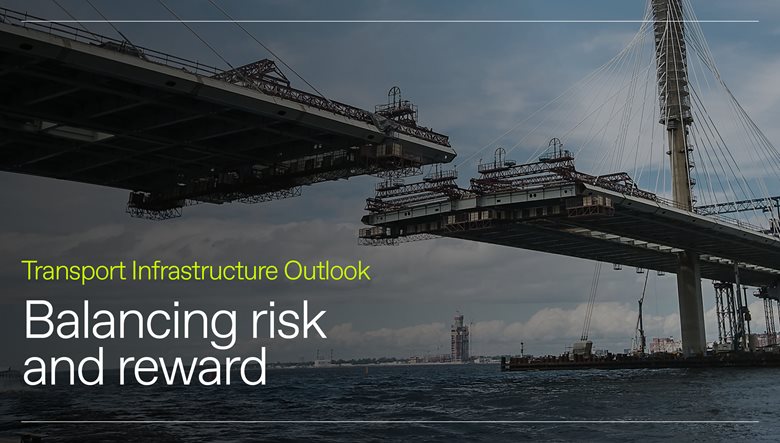Balancing risk and reward in transport infrastructure procurement
How innovation, ESG and risk resilience drive successful project procurement.
By AnsaradaMon Aug 25 2025Industry news and trends, Innovation, Tenders

With governments and private developers racing to meet demands for connectivity, sustainability and economic growth, procurement processes have become a high-stakes balancing act.
Successful projects hinge on a competitive bid process, but also on managing risks, integrating environmental, social and governance (ESG) priorities and using modern tools to streamline workflows.
Drawing on global survey data and expert insights in our 2025 Transport Infrastructure Outlook Report, developed in partnership with Infralogic, this blog explores the critical factors shaping procurement in 2025 and how stakeholders are adapting workstreams to deliver projects on time, within budget and to the highest standards.
1. Consensus prioritizes efficiency
A staggering 60% of respondents identify comprehensive project management processes as the critical factor in procurement success. This emphasis is even stronger in high-growth regions.
Across the Americas and Asia Pacific, 64% of respondents say project management is a critical success factor. For instance, complex projects like US highway upgrades and Canadian smart transit systems demand meticulous coordination. At the same time, megaprojects such as India’s Bharatmala highways and Indonesia’s Jakarta-Bandung High-Speed Rail require robust frameworks to manage scale and bureaucracy.
In EMEA, where 58% of respondents say project management is a critical success factor, Europe’s focus on risk allocation reflects mature markets’ need to balance innovation with regulatory compliance.
While frustrations persist when it comes to document management for large projects, it‘s important to recognise the global digital transformation process that’s currently underway among large construction and engineering organisations is lifting project management practices.
Outdated manual systems are being replaced by purpose-built digital platforms that centralize documentation, automate workflows and enhance transparency. A case in point is Australia’s Level Crossing Removal Project (LXRP), which used digital tools to segment contracts, attracting both tier-one and local contractors. The result was cost savings and faster delivery.
It's just one example of the way procurement teams are turning to purpose-built digital tools to centralize and streamline procurement management.
“Ensuring comprehensive project management without investing in the right software is incredibly difficult. Modern project management is an essential investment,” says one Canadian procurement expert.
The benefits of digital tools are manifold. At a foundational level, real-time collaboration and controlled access to information for stakeholders such as governments, contractors and advisors ensures alignment between different project partners. Digitisation also means audit-ready trails maintain accountability in taxpayer-funded jobs.
2. Mitigating risks in high-stakes projects
Transport infrastructure projects, particularly public-private partnerships (P3s), face multifaceted financial, operational and regulatory risks. Consequently, a range of mitigation strategies are being used by project partners.
Advanced risk analysis tools are vital, according to 65% of private developers, while predictive analytics help model scenarios like inflation spikes or supply chain disruptions. According to 51% of advisors, standardized contracts also play a role in reducing ambiguities.
A comprehensive suite of risk management tools is vital, with 55% of respondents stating insurance safeguards against compliance breaches, zoning disputes and economic volatility are essential.
Nevertheless, long-term P3 agreements are vulnerable to shifting political and economic landscapes.
“Risk allocation is about finding the right balance. A collaborative approach between clients and contractors is essential to avoid misalignment. One way to improve outcomes is by fostering earlier market engagement, which allows contractors to help shape the procurement process. When contractors are involved in defining risks upfront, the process becomes more realistic and sustainable,” says Tom Carey, Partner Infrastructure and Capital Projects at EY Ireland.
3. ESG’s rising (but uneven) influence
While 77% of respondents globally integrate ESG factors to some extent, its role in risk allocation is still emerging. According to the research, 22% of respondents recognize ESG as a key determinant, driven by investor demands and regulations like the EU’s Corporate Sustainability Due Diligence Directive (CSDDD).
But 78% still prioritize traditional risks such as costs and timelines, underscoring ESG’s emerging status.
EMEA is the most advanced region when it comes to ESG, with 58% considering it to a great extent in transport procurement. The findings reveal ESG is embedded via mandates like the EU Green Deal, with a German contractor losing a bid for ignoring supply chain ethics, highlighting compliance rigor.
In the Americas, where more than half of respondents (54%) prioritise ESG, it's also an element of projects that can be highly politicized, For instance, while California mandates green ports, Texas resists overreach. When it comes to ESG
Looking ahead, ESG will increasingly be used as a strategic tool, with forward-thinking teams using ESG to enhance resilience
“To truly embed ESG into risk allocation, it must be given equal weight alongside technical capability and financial performance when selecting preferred bidders,” says Ansarada Business Development Director, EMEA, Andy Potter.
4. Overcoming documentation and collaboration hurdles
Inconsistent record-keeping plagues procurement, with 44% of respondents citing this as a top issue.
It’s a particular issue in Asia-Pacific, where incomplete documents are a problem for 66% of projects. Manual processes are delaying mega projects so much, Vietnam now mandates centralized digital platforms.
Whereas in EMEA, where incomplete documents were named as a challenge by 50% of respondents, EU audit standards are pushing for digitization, yet fragmented national rules persist.
Two-way Q&A platforms that enable real-time stakeholder engagement help to reduce misalignment and version control systems that eliminate errors from scattered files are critical in addressing documentation deficiencies in projects.
Looking ahead
Experts are pressing for more widespread adoption of AI and blockchain technologies to automate tender evaluations and bolster auditability in ESG reporting for transport infrastructure projects.
Ultimately, procurement reform is about creating ecosystems where innovation, equity and accountability converge, underscoring the need for collaborative, future-focused strategies to transform how nations and corporations source goods and uphold sustainability.


